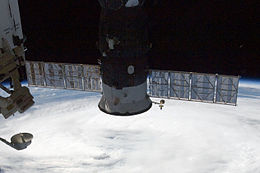 Progress M-16M atop Hurricane Leslie, on 9 September 2012. | |
| Mission type | ISS resupply |
|---|---|
| Operator | Roskosmos |
| COSPAR ID | 2012-042A |
| SATCAT no. | 38738 |
| Mission duration | 192 days |
| Spacecraft properties | |
| Spacecraft type | Progress-M s/n 416 |
| Manufacturer | RKK Energia |
| Launch mass | 6950 kg |
| Start of mission | |
| Launch date | 1 August 2012, 19:35:13 UTC |
| Rocket | Soyuz-U |
| Launch site | Baikonur, Site 1/5 |
| End of mission | |
| Disposal | Deorbited |
| Decay date | 9 February 2013, 17:05 UTC |
| Orbital parameters | |
| Reference system | Geocentric |
| Regime | Low Earth |
| Perigee altitude | 193.0 km |
| Apogee altitude | 245.0 km |
| Inclination | 51.66° |
| Period | 88.58 minutes |
| Epoch | 1 August 2012 |
| Docking with ISS | |
| Docking port | Pirs |
| Docking date | 2 August 2012, 01:24:39 UTC |
| Undocking date | 9 February 2013, 13:16 UTC |
| Time docked | 191 days |
| Cargo | |
| Mass | 2639 kg |
| Pressurised | 1242 kg (dry cargo) |
| Fuel | 680 kg |
| Gaseous | 47 kg (oxygen and air) |
| Water | 420 kg |
Progress ISS Resupply | |
Progress M-16M (Russian: Прогресс М-16М), identified by NASA as Progress 48P, is a Progress spacecraft used by Roskosmos to resupply the International Space Station during 2012. The sixteenth Progress-M 11F615A60 spacecraft, it has the serial number 416 and was built by RKK Energia.
It was the 126th launch to the ISS and the fifteenth Russian space launch in 2012. It was also the seventh mission for the Soyuz family of rockets since the beginning of the year.

